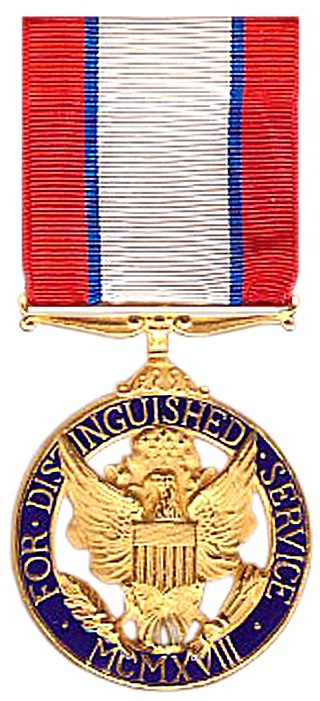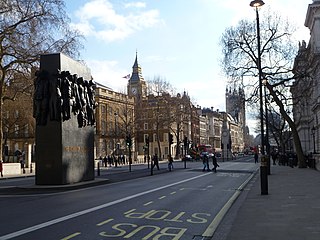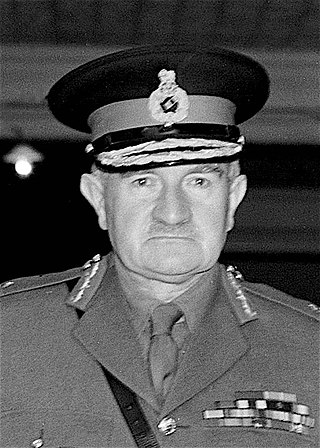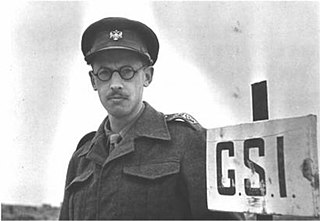
Field Marshal Bernard Law Montgomery, 1st Viscount Montgomery of Alamein,, nicknamed "Monty", was a senior British Army officer who served in the First World War, the Irish War of Independence and the Second World War.

Field Marshal Sir Claude John Eyre Auchinleck,, , was a British Indian Army commander who saw active service during the world wars. A career soldier who spent much of his military career in India, he rose to become commander-in-chief of the Indian Army by early 1941 during the Second World War. In July 1941 he was appointed commander-in-chief of the Middle East Theatre, but after initial successes, the war in North Africa turned against the British-led forces under his command, and he was relieved of the post in August 1942 during the North African campaign.

The Distinguished Service Medal (DSM) is a military decoration of the United States Army that is presented to soldiers who have distinguished themselves by exceptionally meritorious service to the government in a duty of great responsibility. The performance must be such as to merit recognition for service that is clearly exceptional. The exceptional performance of normal duty will not alone justify an award of this decoration.

Harold Rupert Leofric George Alexander, 1st Earl Alexander of Tunis, was a senior and highly decorated British Army officer who served in both of the world wars. In addition, following the end of his military career, he served as Governor General of Canada and became the first Lord Lieutenant of Greater London in 1965.

Whitehall is a road and area in the City of Westminster, Central London, England. The road forms the first part of the A3212 road from Trafalgar Square to Chelsea. It is the main thoroughfare running south from Trafalgar Square towards Parliament Square. The street is recognised as the centre of the Government of the United Kingdom and is lined with numerous departments and ministries, including the Ministry of Defence, Horse Guards and the Cabinet Office. Consequently, the name "Whitehall" is used as a metonym for the British civil service and government, and as the geographic name for the surrounding area.

Field Marshal William Joseph Slim, 1st Viscount Slim,, usually known as Bill Slim, was a British military commander and the 13th Governor-General of Australia.

Operation Baytown was an Allied amphibious landing on the mainland of Italy that took place on 3 September 1943, part of the Allied invasion of Italy, itself part of the Italian Campaign, during the Second World War.

Viscount Montgomery of Alamein, of Hindhead in the County of Surrey, is a title in the Peerage of the United Kingdom.

Field Marshal Hugh Gough, 1st Viscount Gough, was a senior British Army officer. After serving as a junior officer at the seizure of the Cape of Good Hope during the French Revolutionary Wars, Gough commanded the 2nd Battalion of the 87th Regiment of Foot during the Peninsular War. After serving as commander-in-chief of the British forces in China during the First Opium War, he became Commander-in-Chief, India and led the British forces in action against the Marathas defeating them decisively at the conclusion of the Gwalior campaign and then commanded the troops that defeated the Sikhs during both the First Anglo-Sikh War and the Second Anglo-Sikh War.

Lieutenant General Sir Oliver William Hargreaves Leese, 3rd Baronet, was a senior British Army officer who saw distinguished active service during both the world wars. He commanded XXX Corps in North Africa and Sicily, serving under General Sir Bernard Montgomery, before going on to command the Eighth Army in the Italian Campaign throughout most of 1944.

David Bernard Montgomery, 2nd Viscount Montgomery of Alamein, was a British politician and businessman. He was the son of Bernard Montgomery.
The Command and Staff College is the Pakistan Army's staff college for mid-career army officers. As the Army Staff College it was initially established in 1905 at Deolali and later shifted to Quetta in 1907, Baluchistan, British India, now in Pakistan. It has been the alma mater of many renowned soldiers. After the partition of India, those staff not staying in Pakistan moved to Wellington Cantonment and formed the Defence Services Staff College.

The 9th Armoured Brigade was a British Army brigade formed during the Second World War.

Oscar Nemon was a Croatian sculptor who was born in Osijek, Croatia, but eventually settled in England. He is best known for his series of more than a dozen public statues of Sir Winston Churchill.

Henry Hutchinson Montgomery was an Anglican bishop and author.

Brigadier Sir Edgar Trevor Williams was a British historian and Army military intelligence officer who played a significant role in the Second Battle of El Alamein in the Second World War. He was one of the few officers who was privy to the Ultra secret, and served on the staff of Field Marshal Sir Bernard Montgomery as his intelligence officer for the rest of the war.
George Ronald Lewin CBE, later known as Ronald Lewin, was a British officer, publishing editor, radio producer and military historian.

The equestrian statue of the Viscount Wolseley is an outdoor sculpture depicting Garnet Wolseley, 1st Viscount Wolseley, located at the Horse Guards Parade in London, United Kingdom. It is by Sir William Goscombe John and was unveiled by the Duke of Connaught in 1920. The front of the plinth contains an inscription which reads "Wolseley", while the back includes the inscription: "Field-Marshal Viscount Wolseley, KP, GCB, OM, GCMG, 1833–1913, Commander-in-Chief of the British Army, 1895–1900. / Burmah 1852–3 / Crimea 1854–5 / Indian Mutiny 1857–9 / China 1860–1 / Red River 1870 / Ashanti 1873–4 / South Africa 1879 / Egypt 1882 / Soudan 1884–5."

The statue of Alan Brooke, 1st Viscount Alanbrooke by Ivor Roberts-Jones was unveiled in Whitehall, London in 1993.

The statue of William Slim, 1st Viscount Slim in Whitehall, London, is a work of 1988–1993 by the sculptor Ivor Roberts-Jones. It is one of three memorials to British military leaders of World War II on Raleigh Green, outside the Ministry of Defence's Main Building, the others being Oscar Nemon's 1980 statue of Lord Montgomery and Roberts-Jones's statue of Lord Alanbrooke, erected later in 1993. Slim's bronze statue stands approximately 3 metres (9.8 ft) high on a pedestal of Portland stone.



















